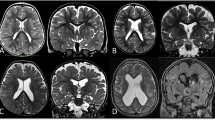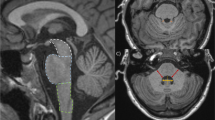Abstract
GPR56-related bilateral frontoparietal polymicrogyria (BFPP) is a rare recessively inherited disorder of neuronal migration caused by mutations of GPR56. To better delineate the clinical, molecular, and neuroradiological phenotypes associated with BFPP, we performed conventional magnetic resonance imaging and diffusion tensor imaging studies in a series of prospectively enrolled patients carrying novel GPR56 mutations. All subjects with GPR56-related BFPP showed a characteristic morphological pattern, including abnormalities of the cerebellar cortex with cerebellar cysts located at the periphery, a mildly thick corpus callosum, and a flat pons. Significant alterations of myelination and white matter tract abnormalities were documented. The present study confirms the phenotypic overlap between GPR56-related brain dysgenesis and other cobblestone-like syndromes and illustrates the contribution of 3D neuroimaging in the characterization of malformations of cortical development.





Similar content being viewed by others
References
Barkovich AJ, Millen KJ, Dobyns WB (2009) A developmental and genetic classification for midbrain–hindbrain malformations. Brain 132:3199–3230
Oh DY, Kim K, Kwon HB, Seong JY (2006) Cellular and molecular biology of orphan G protein-coupled receptors. Int Rev Cytol 252:163–218
Li S, Jin Z, Koirala S et al (2008) GPR56 regulates pial basement membrane integrity and cortical lamination. J Neurosci 28:5817–5826
Bahi-Buisson N, Poirier K, Boddaert N et al (2010) GPR56-related bilateral frontoparietal polymicrogyria: further evidence for an overlap with the cobblestone complex. Brain 133:3194–3209
Piao X, Hill RS, Bodell A et al (2004) G protein-coupled receptor-dependent development of human cortex. Science 303:2033–2036
Parrini E, Ferrari AR, Dorn T et al (2009) Bilateral frontoparietal polymicrogyria, Lennox–Gastaut syndrome, and GPR56 mutations. Epilepsia 50:1344–1353
Luo R, Jeong SJ, Jin Z, Strokes N, Li S, Piao X (2011) G protein-coupled receptor 56 and collagen III, a receptor–ligand pair, regulates cortical development and lamination. Proc Natl Acad Sci U S A 108:12925–12930
Chiang NY, Hsiao CC, Huang YS et al (2011) Disease-associated GPR56 mutations cause bilateral frontoparietal polymicrogyria via multiple mechanisms. J Biol Chem 286:14215–14225
Luo R, Jin Z, Deng Y, Strokes N, Piao X (2012) Disease-associated mutations prevent GPR56–collagen III interaction. PLoS One 7:e29818
Jeong SJ, Li S, Luo R, Strokes N, Piao X (2012) Loss of Col3a1, the gene for Ehlers–Danlos syndrome type IV, results in neocortical dyslamination. PLoS One 7:e29767
Labelle-Dumais C, Dilworth DJ, Harrington EP et al (2011) COL4A1 mutations cause ocular dysgenesis, neuronal localization defects, and myopathy in mice and Walker–Warburg syndrome in humans. PLoS Genet 7:e1002062
Clement E, Mercuri E, Godfrey C et al (2008) Brain involvement in muscular dystrophies with defective dystroglycan glycosylation. Ann Neurol 64:573–582
Acknowledgments
We are grateful to the participants and their families. This work was supported by a grant from Telethon Italy (project GGP08145) and the Italian Ministry of Health.
Ethical standards
The methodology used in this study complies with the current laws of the country in which they were performed.
Conflict of interest
The authors declare that they have no conflict of interest.
Author information
Authors and Affiliations
Corresponding author
Additional information
Carlo C. Quattrocchi and Ginevra Zanni equally contributed to this work.
Electronic supplementary material
Below is the link to the electronic supplementary material.
ESM 1
(DOC 1144 kb)
Rights and permissions
About this article
Cite this article
Quattrocchi, C.C., Zanni, G., Napolitano, A. et al. Conventional magnetic resonance imaging and diffusion tensor imaging studies in children with novel GPR56 mutations: further delineation of a cobblestone-like phenotype. Neurogenetics 14, 77–83 (2013). https://doi.org/10.1007/s10048-012-0352-7
Received:
Accepted:
Published:
Issue Date:
DOI: https://doi.org/10.1007/s10048-012-0352-7




